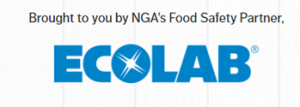December 22, 2022

By Jill Hollingsworth, VP, Food Safety and Retail Industry Relations, Ecolab
Source: FoodSafety.gov
Feasting with family and friends is part of many holiday celebrations. Follow these tips to help prevent food poisoning, or foodborne illness, during the holidays.
- Keep foods separated. Keep meat, chicken, turkey, seafood, and eggs separate from all other foods while shopping at the grocery store and in the refrigerator at home. Prevent juices from meat, chicken, turkey, and seafood from dripping or leaking onto other foods by keeping them in containers or sealed plastic bags. Store eggs in their original carton in the refrigerator.
- Cook food thoroughly. Use a food thermometer to make sure meat, chicken, turkey, seafood, and eggs have been cooked to a safe temperature. Click here for a chart of temperatures that will kill germs: safe internal temperature. Roasts, chops, steaks, and fresh ham should rest for at least 3 minutes after you remove them from the oven or grill.
- Keep food out of the “danger zone.” Bacteria can grow rapidly in the “danger zone” between 40°F and 140°F. After food is prepared, keep hot food hot and cold food cold to avoid this temperature range. Refrigerate or freeze perishable food like meat, chicken, turkey, seafood, eggs, cut fruit, cooked rice, and leftovers within 2 hours (1 hour if food is exposed to temperatures above 90°F, such as in a hot car). The temperature in your refrigerator should be set at 40°F or below and the freezer at 0°F or below.
- Use pasteurized eggs for dishes containing raw eggs. Salmonella and other harmful germs can live on both the outside and inside of normal-looking eggs. Many holiday favorites contain raw eggs, including eggnog, tiramisu, hollandaise sauce, and Caesar dressing. Always use pasteurized eggs when making these and other foods containing raw eggs.
- Do not eat raw dough or batter. Dough and batter made with flour or eggs can contain harmful germs, such as E. coli and Salmonella. Do not taste or eat raw dough or batter that is meant to be baked or cooked. This includes dough or batter for cookies, cakes, pies, biscuits, pancakes, tortillas, pizza, or crafts. Do not let children taste raw dough or batter (no licking the bowl or beaters) or play with dough at home or in restaurants. Some companies and stores offer edible cookie dough that uses heat-treated flour and pasteurized eggs or no eggs. Read the label carefully to make sure the dough is meant to be eaten without baking or cooking.
- Thaw your turkey safely. Thaw turkey in the refrigerator, in a sink of cold water (change the water every 30 minutes), or in the microwave. Do not thaw the turkey or other foods on the counter. Turkey must thaw at a safe temperature to prevent harmful germs from growing rapidly.
- When serving ham, check the label. There are many different types of ham, so it is important to know if the ham is raw (and needs to be cooked before eating) or if the ham is already ready-to-eat. Whether you are cooking raw ham or preparing a ready-to-eat ham product, follow these steps:
- Some raw ham may have the appearance of ready-to-eat products. Raw ham will bear a statement on the label indicating the product needs to be cooked. Ham that requires cooking before consumption or fresh, raw ham must reach an internal temperature of 145°F (with a three-minute rest time). Set the oven no lower than 325°F.
- Cooked canned ham and cooked vacuum-packaged ham can be eaten right out of the package. The label will indicate this is a ready-to-eat product. All of these, along with spiral-cut cooked ham, are safe to eat cold or can be warmed up to an internal temperature of 145°F, as they are already fully cooked.
- Wash your hands with soap and water during these key times to help prevent the spread of germs:
- Before, during, and after preparing food
- Before eating food
- After handling pet food or pet treats or touching pets
- After using the toilet
- After changing diapers or cleaning up a child who has used the toilet
- After touching garbage
- Before and after caring for someone who is sick
- Before and after treating a cut or wound
- After blowing your nose, coughing, or sneezing


